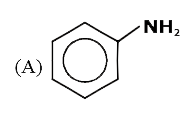Most reactive for nitration is
Benzene
Nitrobenzene
Benzaldehyde
Phenol
The correct Answer is:D
To determine which compound is the most reactive for nitration, we need to analyze the effects of different substituents on the benzene ring. Nitration involves the introduction of a nitro group (NO2) into an aromatic compound, and the reactivity depends on the electron density of the benzene ring.
1. Understanding Nitration:
- Nitration is the process of introducing a nitro group into an aromatic compound. It typically occurs using a mixture of nitric acid (HNO3) and sulfuric acid (H2SO4).
- The sulfuric acid acts as a catalyst and helps generate the nitronium ion (NO2+), which is the active electrophile in the nitration reaction.
2. Identifying the Electrophile:
- The nitronium ion (NO2+) is electron-deficient and seeks to react with areas of high electron density on the benzene ring.
- The presence of electron-donating groups on the benzene ring increases the electron density, making the ring more reactive towards electrophiles like the nitronium ion.
3. Analyzing Substituents:
- Different substituents on the benzene ring can either donate or withdraw electron density:
- Electron-donating groups (EDGs) (like -OH in phenol) increase the electron density of the ring, making it more reactive towards nitration.
- Electron-withdrawing groups (EWGs) (like -NO2 in nitrobenzene) decrease the electron density, making the ring less reactive.
4. Comparing Reactivity:
- If we consider the following compounds:
- Benzene: Neutral reactivity.
- Phenol: Contains an -OH group, which is an EDG, increasing reactivity.
- Nitrobenzene: Contains a -NO2 group, which is an EWG, decreasing reactivity.
- Benzaldehyde: Contains a -CHO group, which is also an EWG, decreasing reactivity.
5. Conclusion:
- Among these options, phenol is the most reactive towards nitration due to the presence of the -OH group, which donates electron density to the benzene ring, enhancing its reactivity with the nitronium ion.
Final Answer:
Phenol is the most reactive for nitration.
- Nitration is the process of introducing a nitro group into an aromatic compound. It typically occurs using a mixture of nitric acid (HNO3) and sulfuric acid (H2SO4).
- The sulfuric acid acts as a catalyst and helps generate the nitronium ion (NO2+), which is the active electrophile in the nitration reaction.
- The nitronium ion (NO2+) is electron-deficient and seeks to react with areas of high electron density on the benzene ring.
- The presence of electron-donating groups on the benzene ring increases the electron density, making the ring more reactive towards electrophiles like the nitronium ion.
- Different substituents on the benzene ring can either donate or withdraw electron density:
- Electron-donating groups (EDGs) (like -OH in phenol) increase the electron density of the ring, making it more reactive towards nitration.
- Electron-withdrawing groups (EWGs) (like -NO2 in nitrobenzene) decrease the electron density, making the ring less reactive.
- If we consider the following compounds:
- Benzene: Neutral reactivity.
- Phenol: Contains an -OH group, which is an EDG, increasing reactivity.
- Nitrobenzene: Contains a -NO2 group, which is an EWG, decreasing reactivity.
- Benzaldehyde: Contains a -CHO group, which is also an EWG, decreasing reactivity.
- Among these options, phenol is the most reactive towards nitration due to the presence of the -OH group, which donates electron density to the benzene ring, enhancing its reactivity with the nitronium ion.
Phenol is the most reactive for nitration.
Similar Questions
Knowledge Check
Most reactive towards nitration reaction (Substitu- tion electrophilic aromatic)
A B
B C
C D
D
Which of the following compounds is the most reactive towards nitration with a mixture of conc. HNO3 and conc. H2SO4 under identical conditions?
AC6H6BC6H5NO2CC6H5CH3DC6H5Cl3The order of decreasing reactivity towards nitration in the following compound is :
 AII>IV>III>IBII>I>III>IVCIII>II>I>IVDI>IV>III>II
AII>IV>III>IBII>I>III>IVCIII>II>I>IVDI>IV>III>II
Arrange the following in order of their reactivity towords nitration

View SolutionWhich of the following is most reactive for hydrolysis?
View SolutionWhich of the following is the most reactive towards ring nitration ?
View SolutionThe most reactive hydrocarbon is
View SolutionThe most reactive hydrocarbon is
View Solution
